
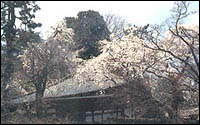 Founded in the 8th century by a monk whose name is venerated in Buddhism
even today, Zenpukuji Temple is a temple steeped in history and lineage.Majestically
standing in the temple's compound are four cherry blossom trees exceeding
270 years in age. Founded in the 8th century by a monk whose name is venerated in Buddhism
even today, Zenpukuji Temple is a temple steeped in history and lineage.Majestically
standing in the temple's compound are four cherry blossom trees exceeding
270 years in age.
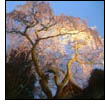 Every year in the beginning of April, visitors come in large numbers to
enjoy the beautiful sight of these trees in bloom. These cherry blossom
trees are called the "trees of the Kobe people" as well as "Kobe's
prized trees." Every year in the beginning of April, visitors come in large numbers to
enjoy the beautiful sight of these trees in bloom. These cherry blossom
trees are called the "trees of the Kobe people" as well as "Kobe's
prized trees."
|
|
|

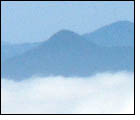 To the north of the Arima hot springs stands Mt. Arima Fuji with an elevation
of 374 meters. From late autumn to early spring, the Ryokan guests are
often treated from the outdoor mineral bath to the spectacle of a "sea
of clouds" among the distant Hokusetsu mountain ranges including Mt.
Arima Fuji. To the north of the Arima hot springs stands Mt. Arima Fuji with an elevation
of 374 meters. From late autumn to early spring, the Ryokan guests are
often treated from the outdoor mineral bath to the spectacle of a "sea
of clouds" among the distant Hokusetsu mountain ranges including Mt.
Arima Fuji.
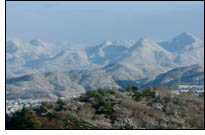
The beautiful sight of the Mt. Arima Fuji has been known since the Edo
period as one of "Arima's Six Splendid Scenic Areas." |
|
|

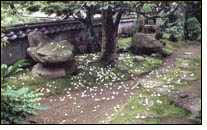 Nenbutsuji Temple has been called the imprint of the villa from Toyotomi
Hideyoshi's wife "Nene" and has a spectacular view of the entire
area. The main hall was built in 1712 and is the oldest building in the
Arima Onsen area. Its garden, called the Sal Tree Garden, features a sal
tree whose age is over 300 years. Nenbutsuji Temple has been called the imprint of the villa from Toyotomi
Hideyoshi's wife "Nene" and has a spectacular view of the entire
area. The main hall was built in 1712 and is the oldest building in the
Arima Onsen area. Its garden, called the Sal Tree Garden, features a sal
tree whose age is over 300 years.
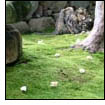 Each year in late June when summer is just beginning in Japan, the tree
displays its beautiful flowers, and there is an appreciation festival held
at the temple for the Sal flower and the ichigen-kin, a one-stringed instrument. Each year in late June when summer is just beginning in Japan, the tree
displays its beautiful flowers, and there is an appreciation festival held
at the temple for the Sal flower and the ichigen-kin, a one-stringed instrument.
|
|
|

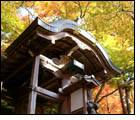 Referring to tranquility of this beautiful Japanese garden of the former
Zuihoji Temple, Toyotomi Hideyoshi once said of the garden, "No matter
how much you see of it, you never grow tired of it." With places for
resting scattered all throughout, the Zuihoji Park is meant to enjoy slowly. Referring to tranquility of this beautiful Japanese garden of the former
Zuihoji Temple, Toyotomi Hideyoshi once said of the garden, "No matter
how much you see of it, you never grow tired of it." With places for
resting scattered all throughout, the Zuihoji Park is meant to enjoy slowly.
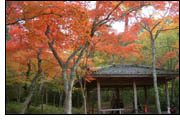 In autumn, visitors can enjoy the beautiful leaves with their autumn hues
while having a bowl of udon noodles, warm oden, or sweet Japanese sake.
The park has also been chosen by Kobe City as one of its 50 designated
places to see beautiful cherry blossoms. In autumn, visitors can enjoy the beautiful leaves with their autumn hues
while having a bowl of udon noodles, warm oden, or sweet Japanese sake.
The park has also been chosen by Kobe City as one of its 50 designated
places to see beautiful cherry blossoms.
|
|
|

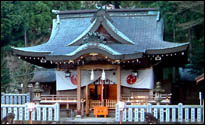 As the place of worship and protectorate of Arima hot springs, Tosen Shrine
holds a first bath of the year ceremony on January 2nd featuring Buddhist
and Shinto priests along with the people of Arima including a group of
geisha girls in traditional bathhouse costumes as they all gather to pray
for the safety of the area. A mikoshi, or portable wooden shrine, contains
the wooden statues of two venerated Buddhist monks and is carried in a
procession. As the place of worship and protectorate of Arima hot springs, Tosen Shrine
holds a first bath of the year ceremony on January 2nd featuring Buddhist
and Shinto priests along with the people of Arima including a group of
geisha girls in traditional bathhouse costumes as they all gather to pray
for the safety of the area. A mikoshi, or portable wooden shrine, contains
the wooden statues of two venerated Buddhist monks and is carried in a
procession.
|
|
|

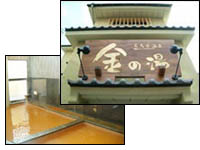 In addition to the hot spring bath facilities at the Japanese inns located
in Arima Onsen area, there are two bathhouses for use by the general public
called "Kin- no-yu" and "Gin-no-yu" respectively. Directly
in front of the "Kin-no-yu," or "Golden Bath," is a
stone inscribed with the words "Foremost hot spring among the gods." In addition to the hot spring bath facilities at the Japanese inns located
in Arima Onsen area, there are two bathhouses for use by the general public
called "Kin- no-yu" and "Gin-no-yu" respectively. Directly
in front of the "Kin-no-yu," or "Golden Bath," is a
stone inscribed with the words "Foremost hot spring among the gods."
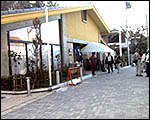 Steeped in history, Arima Onsen got its start according to Japanese legend
when the two gods that created Japan discovered it at the Arima gorge in
the Mt. Rokko mountain range. It is considered one of the three ancient
springs of Japan along with Dogo Onsen and Shirahama Onsen and ranks in
the top three hot springs together with Kusatsu Onsen and Gero Onsen. Steeped in history, Arima Onsen got its start according to Japanese legend
when the two gods that created Japan discovered it at the Arima gorge in
the Mt. Rokko mountain range. It is considered one of the three ancient
springs of Japan along with Dogo Onsen and Shirahama Onsen and ranks in
the top three hot springs together with Kusatsu Onsen and Gero Onsen.
|
|
|

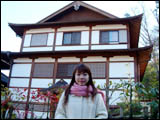 When the Gokurakuji Temple's kitchen was being rebuilt from its collapse
during the Kobe Earthquake in 1993, workers discovered ruins dating back
more than 400 years before. Upon examination, it became clear that these
ruins were the bath and garden of Yunoyama Goten built by Taiko Hideyoshi. When the Gokurakuji Temple's kitchen was being rebuilt from its collapse
during the Kobe Earthquake in 1993, workers discovered ruins dating back
more than 400 years before. Upon examination, it became clear that these
ruins were the bath and garden of Yunoyama Goten built by Taiko Hideyoshi.
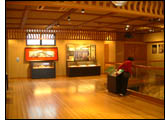 To commemorate the site, the city of Kobe opened a museum in April 1999
exhibiting the mushiburo (steam bath) and iwaburo (bath in stone) and preserved
these baths in their original condition along with tea ceremony items and
Japanese tile discovered at the ruins indicating the relationship of Hideyoshi
and Arima Onsen. To commemorate the site, the city of Kobe opened a museum in April 1999
exhibiting the mushiburo (steam bath) and iwaburo (bath in stone) and preserved
these baths in their original condition along with tea ceremony items and
Japanese tile discovered at the ruins indicating the relationship of Hideyoshi
and Arima Onsen.
|
|
|

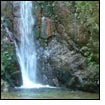 As with Zuihoji Park, Tsuzumigataki Park is a park famous for its beauty
scenery. The park got its name from the waterfall where a drum-like sound
can be heard from the water striking the ground and reverberating in the
rock formation. Named for Japanese drum used in kabuki, Tsuzumi reveals
a special characteristic with each season. As with Zuihoji Park, Tsuzumigataki Park is a park famous for its beauty
scenery. The park got its name from the waterfall where a drum-like sound
can be heard from the water striking the ground and reverberating in the
rock formation. Named for Japanese drum used in kabuki, Tsuzumi reveals
a special characteristic with each season.
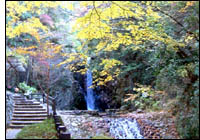 In spring the thoughts of the visitor are washed pure by the water reflecting
the new green foliage while in the summer visitors are greeted with the
fluttering of fireflies and the singing of Kajika frogs. In the autumn, many
people enjoy strolling through the forest and gazing at the beautiful autumn
leaves. In spring the thoughts of the visitor are washed pure by the water reflecting
the new green foliage while in the summer visitors are greeted with the
fluttering of fireflies and the singing of Kajika frogs. In the autumn, many
people enjoy strolling through the forest and gazing at the beautiful autumn
leaves.
EThe Fireflies of Arimagawa River |
|
|

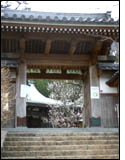 Rinkeiji is an old, historical temple founded in 1601. The compound has
a red blossom plum tree named Mikaiko that is more than 200 years old.
Every year at the end of March, the beautiful crimson flowers blossom in
multiple layers. Rinkeiji is an old, historical temple founded in 1601. The compound has
a red blossom plum tree named Mikaiko that is more than 200 years old.
Every year at the end of March, the beautiful crimson flowers blossom in
multiple layers.
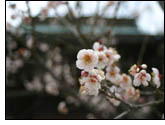 From ancient times, it is said that those that eat the fruit of the plums
will be blessed with a child. For this reason, the plums are called the
"plums of the nymphs". From ancient times, it is said that those that eat the fruit of the plums
will be blessed with a child. For this reason, the plums are called the
"plums of the nymphs".
|
|
|

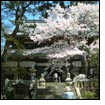 Gyoki, the name of a famous Buddhist monk who founded Arima Onsen, built
this old venerable temple in the 8th century. Gyoki, the name of a famous Buddhist monk who founded Arima Onsen, built
this old venerable temple in the 8th century.
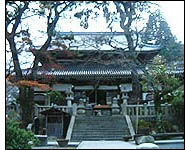 Another monk who deeply respected Gyoki followed in Gyoki's footsteps by
restoring Arima Onsen in the 12th century. The current buildings were rebuilt
and consolidated in 1782 to form the temple that local people fondly call
Yakushi-san. Another monk who deeply respected Gyoki followed in Gyoki's footsteps by
restoring Arima Onsen in the 12th century. The current buildings were rebuilt
and consolidated in 1782 to form the temple that local people fondly call
Yakushi-san.
|
|
|

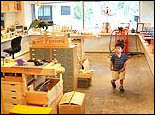 Not only children but adults too enjoy this special museum that specializes
in toys. Around 4,000 items have been collected from five other countries
around the world and are on display including toys from Germany and the
Czech Republic. Not only children but adults too enjoy this special museum that specializes
in toys. Around 4,000 items have been collected from five other countries
around the world and are on display including toys from Germany and the
Czech Republic.
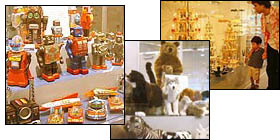
Of those exhibited about 1300 are specialty dolls. A doll studio at the
museum gives visitors an opportunity to watch dolls being constructed.
|
|
|

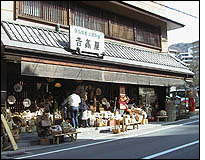 With a history spanning 1300 years, Arima Onsen retains the time-honored
ways of the past. Shops with traditional crafts such as those selling Arima
doll pens and traditional baskets stand next to shops with storefronts
baking soda crackers. Aligned together with these shops are various essential
shops for daily living such as meat and flower shops. With a history spanning 1300 years, Arima Onsen retains the time-honored
ways of the past. Shops with traditional crafts such as those selling Arima
doll pens and traditional baskets stand next to shops with storefronts
baking soda crackers. Aligned together with these shops are various essential
shops for daily living such as meat and flower shops.
|
|
|

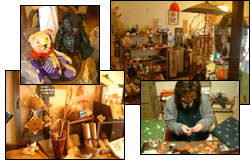 To the immediate left of Arima Onsen Station, there is a shop called Kirakuya
that utilizes the restored 1st floor of a ryokan building built in the
1930's. The shop sells Japanese knick-knacks along with cloth items dyed
using the mineral water from Arima's golden bath. Visitors can enjoy an
old-time atmosphere at the Kirakuya tearoom. To the immediate left of Arima Onsen Station, there is a shop called Kirakuya
that utilizes the restored 1st floor of a ryokan building built in the
1930's. The shop sells Japanese knick-knacks along with cloth items dyed
using the mineral water from Arima's golden bath. Visitors can enjoy an
old-time atmosphere at the Kirakuya tearoom.
|
|
|

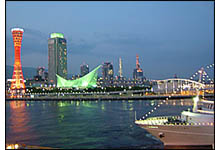 Cruises originating from Kobe Harbor offer spectacular views of Kobe with
the towering mountain range of Mt. Rokko overlooking the Seto Inland Sea
and extending along the coast like a folding screen. With its beautiful
scenery, Kobe, a prosperous port city that served as a gateway to Kyushu
and Mainland China almost 1000 years before, developed as a harbor for
international trade after the Meiji Restoration and was a site for foreign
settlements. Today, Kobe maintains its international atmosphere with many
exotic sightseeing places teeming with multi-cultures from other countries. Cruises originating from Kobe Harbor offer spectacular views of Kobe with
the towering mountain range of Mt. Rokko overlooking the Seto Inland Sea
and extending along the coast like a folding screen. With its beautiful
scenery, Kobe, a prosperous port city that served as a gateway to Kyushu
and Mainland China almost 1000 years before, developed as a harbor for
international trade after the Meiji Restoration and was a site for foreign
settlements. Today, Kobe maintains its international atmosphere with many
exotic sightseeing places teeming with multi-cultures from other countries.
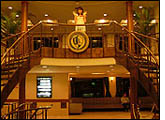 A variety of cruises are available from Kobe Harbor ranging in length from
30 minutes to more than 2 hours. Those taking the Akashi Kaikyo Bridge
dinner cruise will be impressed with the incredible night view that appears
like a glittering white pearl necklace floating on the dark sea. A variety of cruises are available from Kobe Harbor ranging in length from
30 minutes to more than 2 hours. Those taking the Akashi Kaikyo Bridge
dinner cruise will be impressed with the incredible night view that appears
like a glittering white pearl necklace floating on the dark sea.
|
|
|

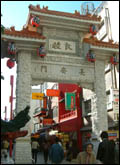 The birth of Nankinmachi is said to have begun with the opening of the
Kobe port in 1867. At that time there were already a number of overseas
living in the south area of Motomachi, and this caused businesses such
as tailor shops, pork shops, Chinese medicine shops and restaurants to
appear nearby. The birth of Nankinmachi is said to have begun with the opening of the
Kobe port in 1867. At that time there were already a number of overseas
living in the south area of Motomachi, and this caused businesses such
as tailor shops, pork shops, Chinese medicine shops and restaurants to
appear nearby.
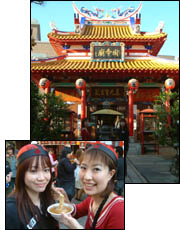 In the beginning of the 20th century, customers from all over Japan began
coming to Nankinmachi for the wide range of products causing people to
say, "you can find anything at Nankinmachi." Conditions suffered
afterward with the bombing of Kobe during World War II and the subsequent
destruction; however, in the 1980's, there was a Nankinmachi revival with
the area being given a Chinese motif that can be seen today. The prosperity
in the area has recovered due to the Chinese New Year's and Spring Welcoming
festivals that have been increasingly gaining popularity nationwide. In the beginning of the 20th century, customers from all over Japan began
coming to Nankinmachi for the wide range of products causing people to
say, "you can find anything at Nankinmachi." Conditions suffered
afterward with the bombing of Kobe during World War II and the subsequent
destruction; however, in the 1980's, there was a Nankinmachi revival with
the area being given a Chinese motif that can be seen today. The prosperity
in the area has recovered due to the Chinese New Year's and Spring Welcoming
festivals that have been increasingly gaining popularity nationwide.
[ Shunsetsu: Spring Festival 2015 in Kobe's Chinatown ]
|
|
|

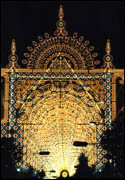 The Kobe Luminarie is held every winter from early December for two weeks. The Kobe Luminarie is held every winter from early December for two weeks.
"Luminarie is the plural form of Italian word gluminariah that stands
for Illumination with miniature bulbs.
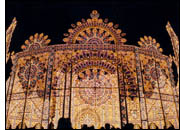 It began eleven months after the Kobe Earthquake in 1995 with the hope
to give courage and greatly inspire the people of Kobe. Because there was
a strong desire for continuation after its conclusion, it became an annual
event symbolizing the hope of Kobe citizens. It began eleven months after the Kobe Earthquake in 1995 with the hope
to give courage and greatly inspire the people of Kobe. Because there was
a strong desire for continuation after its conclusion, it became an annual
event symbolizing the hope of Kobe citizens.
|
|





















 Founded in the 8th century by a monk whose name is venerated in Buddhism
even today, Zenpukuji Temple is a temple steeped in history and lineage.Majestically
standing in the temple's compound are four cherry blossom trees exceeding
270 years in age.
Founded in the 8th century by a monk whose name is venerated in Buddhism
even today, Zenpukuji Temple is a temple steeped in history and lineage.Majestically
standing in the temple's compound are four cherry blossom trees exceeding
270 years in age. Every year in the beginning of April, visitors come in large numbers to
enjoy the beautiful sight of these trees in bloom. These cherry blossom
trees are called the "trees of the Kobe people" as well as "Kobe's
prized trees."
Every year in the beginning of April, visitors come in large numbers to
enjoy the beautiful sight of these trees in bloom. These cherry blossom
trees are called the "trees of the Kobe people" as well as "Kobe's
prized trees." To the north of the Arima hot springs stands Mt. Arima Fuji with an elevation
of 374 meters. From late autumn to early spring, the Ryokan guests are
often treated from the outdoor mineral bath to the spectacle of a "sea
of clouds" among the distant Hokusetsu mountain ranges including Mt.
Arima Fuji.
To the north of the Arima hot springs stands Mt. Arima Fuji with an elevation
of 374 meters. From late autumn to early spring, the Ryokan guests are
often treated from the outdoor mineral bath to the spectacle of a "sea
of clouds" among the distant Hokusetsu mountain ranges including Mt.
Arima Fuji.
 Nenbutsuji Temple has been called the imprint of the villa from Toyotomi
Hideyoshi's wife "Nene" and has a spectacular view of the entire
area. The main hall was built in 1712 and is the oldest building in the
Arima Onsen area. Its garden, called the Sal Tree Garden, features a sal
tree whose age is over 300 years.
Nenbutsuji Temple has been called the imprint of the villa from Toyotomi
Hideyoshi's wife "Nene" and has a spectacular view of the entire
area. The main hall was built in 1712 and is the oldest building in the
Arima Onsen area. Its garden, called the Sal Tree Garden, features a sal
tree whose age is over 300 years.  Each year in late June when summer is just beginning in Japan, the tree
displays its beautiful flowers, and there is an appreciation festival held
at the temple for the Sal flower and the ichigen-kin, a one-stringed instrument.
Each year in late June when summer is just beginning in Japan, the tree
displays its beautiful flowers, and there is an appreciation festival held
at the temple for the Sal flower and the ichigen-kin, a one-stringed instrument. Referring to tranquility of this beautiful Japanese garden of the former
Zuihoji Temple, Toyotomi Hideyoshi once said of the garden, "No matter
how much you see of it, you never grow tired of it." With places for
resting scattered all throughout, the Zuihoji Park is meant to enjoy slowly.
Referring to tranquility of this beautiful Japanese garden of the former
Zuihoji Temple, Toyotomi Hideyoshi once said of the garden, "No matter
how much you see of it, you never grow tired of it." With places for
resting scattered all throughout, the Zuihoji Park is meant to enjoy slowly.
 In autumn, visitors can enjoy the beautiful leaves with their autumn hues
while having a bowl of udon noodles, warm oden, or sweet Japanese sake.
The park has also been chosen by Kobe City as one of its 50 designated
places to see beautiful cherry blossoms.
In autumn, visitors can enjoy the beautiful leaves with their autumn hues
while having a bowl of udon noodles, warm oden, or sweet Japanese sake.
The park has also been chosen by Kobe City as one of its 50 designated
places to see beautiful cherry blossoms. As the place of worship and protectorate of Arima hot springs, Tosen Shrine
holds a first bath of the year ceremony on January 2nd featuring Buddhist
and Shinto priests along with the people of Arima including a group of
geisha girls in traditional bathhouse costumes as they all gather to pray
for the safety of the area. A mikoshi, or portable wooden shrine, contains
the wooden statues of two venerated Buddhist monks and is carried in a
procession.
As the place of worship and protectorate of Arima hot springs, Tosen Shrine
holds a first bath of the year ceremony on January 2nd featuring Buddhist
and Shinto priests along with the people of Arima including a group of
geisha girls in traditional bathhouse costumes as they all gather to pray
for the safety of the area. A mikoshi, or portable wooden shrine, contains
the wooden statues of two venerated Buddhist monks and is carried in a
procession. In addition to the hot spring bath facilities at the Japanese inns located
in Arima Onsen area, there are two bathhouses for use by the general public
called "Kin- no-yu" and "Gin-no-yu" respectively. Directly
in front of the "Kin-no-yu," or "Golden Bath," is a
stone inscribed with the words "Foremost hot spring among the gods."
In addition to the hot spring bath facilities at the Japanese inns located
in Arima Onsen area, there are two bathhouses for use by the general public
called "Kin- no-yu" and "Gin-no-yu" respectively. Directly
in front of the "Kin-no-yu," or "Golden Bath," is a
stone inscribed with the words "Foremost hot spring among the gods." Steeped in history, Arima Onsen got its start according to Japanese legend
when the two gods that created Japan discovered it at the Arima gorge in
the Mt. Rokko mountain range. It is considered one of the three ancient
springs of Japan along with Dogo Onsen and Shirahama Onsen and ranks in
the top three hot springs together with Kusatsu Onsen and Gero Onsen.
Steeped in history, Arima Onsen got its start according to Japanese legend
when the two gods that created Japan discovered it at the Arima gorge in
the Mt. Rokko mountain range. It is considered one of the three ancient
springs of Japan along with Dogo Onsen and Shirahama Onsen and ranks in
the top three hot springs together with Kusatsu Onsen and Gero Onsen. When the Gokurakuji Temple's kitchen was being rebuilt from its collapse
during the Kobe Earthquake in 1993, workers discovered ruins dating back
more than 400 years before. Upon examination, it became clear that these
ruins were the bath and garden of Yunoyama Goten built by Taiko Hideyoshi.
When the Gokurakuji Temple's kitchen was being rebuilt from its collapse
during the Kobe Earthquake in 1993, workers discovered ruins dating back
more than 400 years before. Upon examination, it became clear that these
ruins were the bath and garden of Yunoyama Goten built by Taiko Hideyoshi.
 To commemorate the site, the city of Kobe opened a museum in April 1999
exhibiting the mushiburo (steam bath) and iwaburo (bath in stone) and preserved
these baths in their original condition along with tea ceremony items and
Japanese tile discovered at the ruins indicating the relationship of Hideyoshi
and Arima Onsen.
To commemorate the site, the city of Kobe opened a museum in April 1999
exhibiting the mushiburo (steam bath) and iwaburo (bath in stone) and preserved
these baths in their original condition along with tea ceremony items and
Japanese tile discovered at the ruins indicating the relationship of Hideyoshi
and Arima Onsen. As with Zuihoji Park, Tsuzumigataki Park is a park famous for its beauty
scenery. The park got its name from the waterfall where a drum-like sound
can be heard from the water striking the ground and reverberating in the
rock formation. Named for Japanese drum used in kabuki, Tsuzumi reveals
a special characteristic with each season.
As with Zuihoji Park, Tsuzumigataki Park is a park famous for its beauty
scenery. The park got its name from the waterfall where a drum-like sound
can be heard from the water striking the ground and reverberating in the
rock formation. Named for Japanese drum used in kabuki, Tsuzumi reveals
a special characteristic with each season.  In spring the thoughts of the visitor are washed pure by the water reflecting
the new green foliage while in the summer visitors are greeted with the
fluttering of fireflies and the singing of Kajika frogs. In the autumn, many
people enjoy strolling through the forest and gazing at the beautiful autumn
leaves.
In spring the thoughts of the visitor are washed pure by the water reflecting
the new green foliage while in the summer visitors are greeted with the
fluttering of fireflies and the singing of Kajika frogs. In the autumn, many
people enjoy strolling through the forest and gazing at the beautiful autumn
leaves. Rinkeiji is an old, historical temple founded in 1601. The compound has
a red blossom plum tree named Mikaiko that is more than 200 years old.
Every year at the end of March, the beautiful crimson flowers blossom in
multiple layers.
Rinkeiji is an old, historical temple founded in 1601. The compound has
a red blossom plum tree named Mikaiko that is more than 200 years old.
Every year at the end of March, the beautiful crimson flowers blossom in
multiple layers. From ancient times, it is said that those that eat the fruit of the plums
will be blessed with a child. For this reason, the plums are called the
"plums of the nymphs".
From ancient times, it is said that those that eat the fruit of the plums
will be blessed with a child. For this reason, the plums are called the
"plums of the nymphs". Gyoki, the name of a famous Buddhist monk who founded Arima Onsen, built
this old venerable temple in the 8th century.
Gyoki, the name of a famous Buddhist monk who founded Arima Onsen, built
this old venerable temple in the 8th century. Another monk who deeply respected Gyoki followed in Gyoki's footsteps by
restoring Arima Onsen in the 12th century. The current buildings were rebuilt
and consolidated in 1782 to form the temple that local people fondly call
Yakushi-san.
Another monk who deeply respected Gyoki followed in Gyoki's footsteps by
restoring Arima Onsen in the 12th century. The current buildings were rebuilt
and consolidated in 1782 to form the temple that local people fondly call
Yakushi-san. Not only children but adults too enjoy this special museum that specializes
in toys. Around 4,000 items have been collected from five other countries
around the world and are on display including toys from Germany and the
Czech Republic.
Not only children but adults too enjoy this special museum that specializes
in toys. Around 4,000 items have been collected from five other countries
around the world and are on display including toys from Germany and the
Czech Republic.
 With a history spanning 1300 years, Arima Onsen retains the time-honored
ways of the past. Shops with traditional crafts such as those selling Arima
doll pens and traditional baskets stand next to shops with storefronts
baking soda crackers. Aligned together with these shops are various essential
shops for daily living such as meat and flower shops.
With a history spanning 1300 years, Arima Onsen retains the time-honored
ways of the past. Shops with traditional crafts such as those selling Arima
doll pens and traditional baskets stand next to shops with storefronts
baking soda crackers. Aligned together with these shops are various essential
shops for daily living such as meat and flower shops. To the immediate left of Arima Onsen Station, there is a shop called Kirakuya
that utilizes the restored 1st floor of a ryokan building built in the
1930's. The shop sells Japanese knick-knacks along with cloth items dyed
using the mineral water from Arima's golden bath. Visitors can enjoy an
old-time atmosphere at the Kirakuya tearoom.
To the immediate left of Arima Onsen Station, there is a shop called Kirakuya
that utilizes the restored 1st floor of a ryokan building built in the
1930's. The shop sells Japanese knick-knacks along with cloth items dyed
using the mineral water from Arima's golden bath. Visitors can enjoy an
old-time atmosphere at the Kirakuya tearoom. Cruises originating from Kobe Harbor offer spectacular views of Kobe with
the towering mountain range of Mt. Rokko overlooking the Seto Inland Sea
and extending along the coast like a folding screen. With its beautiful
scenery, Kobe, a prosperous port city that served as a gateway to Kyushu
and Mainland China almost 1000 years before, developed as a harbor for
international trade after the Meiji Restoration and was a site for foreign
settlements. Today, Kobe maintains its international atmosphere with many
exotic sightseeing places teeming with multi-cultures from other countries.
Cruises originating from Kobe Harbor offer spectacular views of Kobe with
the towering mountain range of Mt. Rokko overlooking the Seto Inland Sea
and extending along the coast like a folding screen. With its beautiful
scenery, Kobe, a prosperous port city that served as a gateway to Kyushu
and Mainland China almost 1000 years before, developed as a harbor for
international trade after the Meiji Restoration and was a site for foreign
settlements. Today, Kobe maintains its international atmosphere with many
exotic sightseeing places teeming with multi-cultures from other countries.
 A variety of cruises are available from Kobe Harbor ranging in length from
30 minutes to more than 2 hours. Those taking the Akashi Kaikyo Bridge
dinner cruise will be impressed with the incredible night view that appears
like a glittering white pearl necklace floating on the dark sea.
A variety of cruises are available from Kobe Harbor ranging in length from
30 minutes to more than 2 hours. Those taking the Akashi Kaikyo Bridge
dinner cruise will be impressed with the incredible night view that appears
like a glittering white pearl necklace floating on the dark sea. The birth of Nankinmachi is said to have begun with the opening of the
Kobe port in 1867. At that time there were already a number of overseas
living in the south area of Motomachi, and this caused businesses such
as tailor shops, pork shops, Chinese medicine shops and restaurants to
appear nearby.
The birth of Nankinmachi is said to have begun with the opening of the
Kobe port in 1867. At that time there were already a number of overseas
living in the south area of Motomachi, and this caused businesses such
as tailor shops, pork shops, Chinese medicine shops and restaurants to
appear nearby. In the beginning of the 20th century, customers from all over Japan began
coming to Nankinmachi for the wide range of products causing people to
say, "you can find anything at Nankinmachi." Conditions suffered
afterward with the bombing of Kobe during World War II and the subsequent
destruction; however, in the 1980's, there was a Nankinmachi revival with
the area being given a Chinese motif that can be seen today. The prosperity
in the area has recovered due to the Chinese New Year's and Spring Welcoming
festivals that have been increasingly gaining popularity nationwide.
In the beginning of the 20th century, customers from all over Japan began
coming to Nankinmachi for the wide range of products causing people to
say, "you can find anything at Nankinmachi." Conditions suffered
afterward with the bombing of Kobe during World War II and the subsequent
destruction; however, in the 1980's, there was a Nankinmachi revival with
the area being given a Chinese motif that can be seen today. The prosperity
in the area has recovered due to the Chinese New Year's and Spring Welcoming
festivals that have been increasingly gaining popularity nationwide. The Kobe Luminarie is held every winter from early December for two weeks.
The Kobe Luminarie is held every winter from early December for two weeks. It began eleven months after the Kobe Earthquake in 1995 with the hope
to give courage and greatly inspire the people of Kobe. Because there was
a strong desire for continuation after its conclusion, it became an annual
event symbolizing the hope of Kobe citizens.
It began eleven months after the Kobe Earthquake in 1995 with the hope
to give courage and greatly inspire the people of Kobe. Because there was
a strong desire for continuation after its conclusion, it became an annual
event symbolizing the hope of Kobe citizens.